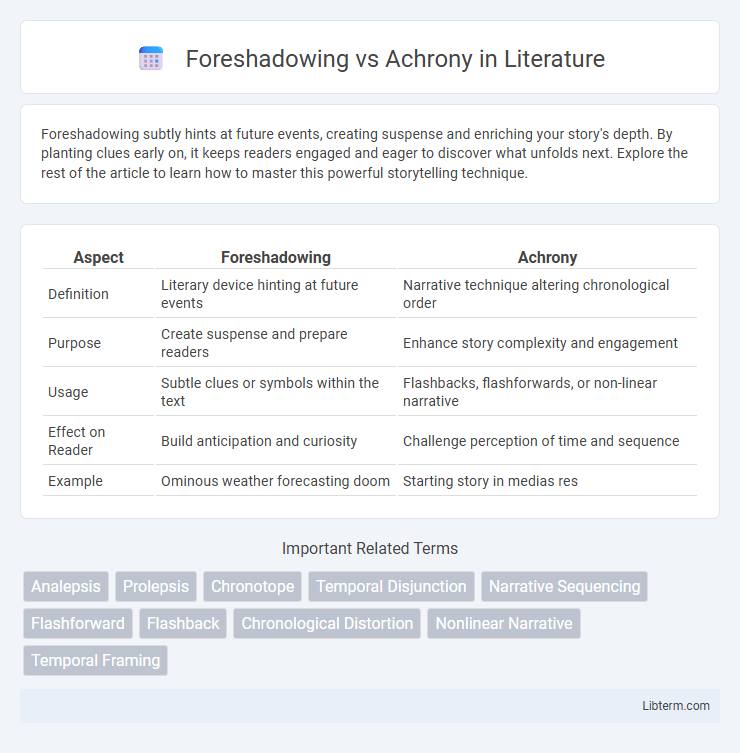Foreshadowing subtly hints at future events, creating suspense and enriching your story's depth. By planting clues early on, it keeps readers engaged and eager to discover what unfolds next. Explore the rest of the article to learn how to master this powerful storytelling technique.
Table of Comparison
| Aspect | Foreshadowing | Achrony |
|---|---|---|
| Definition | Literary device hinting at future events | Narrative technique altering chronological order |
| Purpose | Create suspense and prepare readers | Enhance story complexity and engagement |
| Usage | Subtle clues or symbols within the text | Flashbacks, flashforwards, or non-linear narrative |
| Effect on Reader | Build anticipation and curiosity | Challenge perception of time and sequence |
| Example | Ominous weather forecasting doom | Starting story in medias res |
Understanding Foreshadowing: Definition and Purpose
Foreshadowing is a literary device used to provide subtle hints or clues about future events in a narrative, creating anticipation and building suspense. It serves to prepare the audience emotionally and intellectually for upcoming plot developments, enriching the overall storytelling experience. By strategically embedding foreshadowing, authors enhance narrative cohesion and deepen thematic resonance within their works.
Achrony Explained: Breaking Traditional Chronology
Achrony disrupts linear narrative flow by presenting events out of chronological order, enhancing thematic depth and audience engagement through non-sequential storytelling. Unlike foreshadowing, which subtly hints at future events within a chronological framework, achrony reshapes temporal perception by interweaving past, present, and future moments simultaneously. This technique challenges traditional time structures, enabling complex character development and multifaceted plot exploration in literature and film.
Key Differences Between Foreshadowing and Achrony
Foreshadowing involves deliberately hinting at future events within a narrative to prepare the audience, while achrony disrupts the chronological order by presenting events out of sequence. Key differences include foreshadowing's role in building suspense and anticipation compared to achrony's function in creating complex narrative structures or emphasizing thematic elements. Foreshadowing is a linear narrative device, whereas achrony often employs flashbacks, flash-forwards, or non-linear timelines to challenge traditional storytelling.
Narrative Techniques: How Foreshadowing Shapes Storytelling
Foreshadowing strategically plants subtle hints and symbols early in a narrative, enhancing suspense and guiding audience expectations. Unlike achrony, which disrupts linear time by presenting events out of sequence, foreshadowing maintains chronological order while enriching the story's thematic depth and emotional resonance. This technique sharpens narrative cohesion by linking future outcomes with present moments, thereby intensifying engagement and meaning.
The Impact of Achrony on Narrative Structure
Achrony disrupts traditional chronological order by presenting events out of sequence, creating a non-linear narrative that challenges readers' perception of time. This narrative technique intensifies suspense and deepens thematic complexity by forcing the audience to actively piece together the storyline. Unlike foreshadowing, which hints at future events, achrony redefines cause and effect, reshaping character development and plot progression in innovative ways.
Examples of Foreshadowing in Literature and Film
Foreshadowing in literature and film subtly hints at future plot developments through specific details, such as the ominous weather in Shakespeare's "Macbeth" or the recurring motif of the white whale in Melville's "Moby-Dick." In movies, foreshadowing is evident in "The Sixth Sense," where visual cues and dialogue suggest the twist about the protagonist's true state. These narrative techniques create suspense and prepare audiences for key revelations, contrasting with achrony, which disrupts chronological order to enhance storytelling complexity.
Notable Uses of Achrony Across Genres
Achrony, characterized by the non-linear arrangement of events, is notably employed in genres like mystery, science fiction, and psychological thrillers to enhance narrative complexity and audience engagement. Classic examples include Gabriel Garcia Marquez's "One Hundred Years of Solitude," where time fluidity deepens thematic elements, and Christopher Nolan's "Memento," which uses reverse chronology to mirror its protagonist's memory loss. This technique contrasts with foreshadowing by disrupting temporal order rather than hinting at future outcomes, making it a powerful tool for creating suspense and deepening character exploration.
Reader Engagement: Foreshadowing vs. Achrony
Foreshadowing enhances reader engagement by creating anticipation and suspense through subtle hints about future events, encouraging active prediction and emotional investment. Achrony disrupts linear time, stimulating curiosity and deeper analysis as readers piece together non-sequential narrative elements to understand the plot. Both techniques enrich the reading experience by fostering immersive cognitive involvement and maintaining interest throughout the story.
When to Use Foreshadowing or Achrony in Writing
Foreshadowing is best used when writers want to create suspense or hint at future events, enhancing narrative cohesion and reader engagement. Achrony suits stories that benefit from non-linear timelines, revealing character motivations or plot complexities in a layered, intriguing manner. Choosing between foreshadowing and achrony depends on the desired pacing, thematic emphasis, and emotional impact within the story structure.
Crafting Effective Narratives: Blending Foreshadowing and Achrony
Blending foreshadowing and achrony in narrative crafts dynamic storytelling by strategically hinting at future events while manipulating chronological order. Foreshadowing builds anticipation and deepens thematic resonance, whereas achrony disrupts linear time to enhance mystery and engage readers in active interpretation. Effective use of both techniques creates layered plots that balance predictability with surprise, enriching overall narrative experience.
Foreshadowing Infographic

 libterm.com
libterm.com